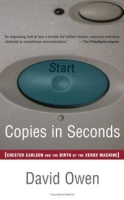| Copies in Seconds: How a Lone Inventor and an Unknown Company Created the Biggest Communication Breakthrough Since Gutenberg--Chester Carlson and the Birth of Xerox артикул 9978c. |
 |
A lone inventor and the story of how one of the most revolutionary inventions of the twentieth century almost didn't happen Introduced in 1960, the first plain-paper office copier is unusual among major high-technology invenions in that its central process was conceived by a single person Chester Carlson grew up in unspeakable poverty, worked оехщы his way through junior college and the California Institute of Technology, and made his discovery in solitude in the depths of the Grat Depression He offered his big idea to two dozen major corporations -- among them IBM, RCA, and General Electric -- all of which turned him down So persistent was this failure of capitalistic vision that by the time the Xerox 914 was manufactured, by n obscure photographic-supply company in Rochester, New York, Carlson's original patent had expired Xerography was so unusual and nonintuitive that it conceivably could have been overlooked entirely Scientists who visited the drafty warehouses where te first machines were built sometimes doubted that Carlson's invention was even theoretically feasible Building the first plain-paper office copier -- with parts scrounged from junkyards, cleaning brushes made of hand-sewn rabbit fur, and a built-in fireextinguisher -- required the persistence, courage, and imagination of an extraordinary group of physicists, engineers, and corporate executives whose story has never before been fully told Copies in Seconds is a tale of corporate innovation and isk-taking at its very best. Редактор:2005 г Мягкая обложка, 320 стр ISBN 0743251180. |